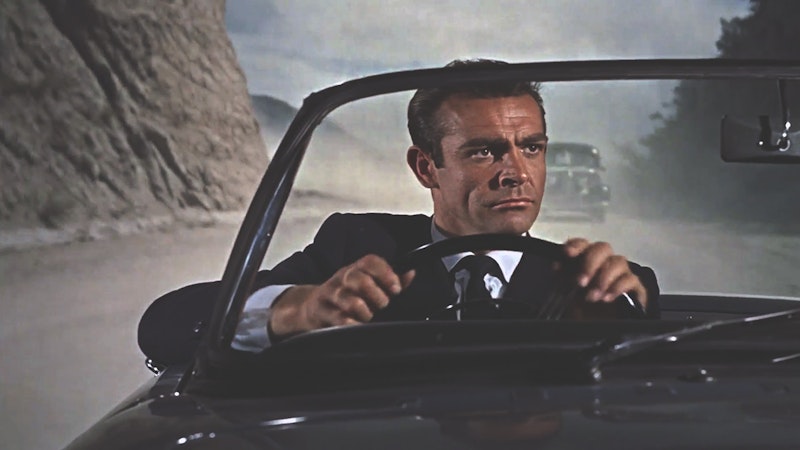Big things were happening in British cinema in 1962. The New Wave was in full swing in France, and the British had a New Wave of their own, exploring similar radical film techniques. The British wave was shaped by the Angry Young Men, writers in theater and cinema who challenged the establishment and articulated working-class reality. And none of this turned up in the most financially successful British film of the year.
While Lawrence of Arabia made $70 million around the world for a production cost of $15 million, Dr. No made just shy of $60 million for a cost of just a million. That’s not much of a budget, but the movie worked anyway. Beyond being a box-office hit, the first James Bond film remains one of the best.
It’s striking how much Dr. No set a template for decades of Bond films to follow. The title sequence. The classic theme music, rerecorded and rearranged many times over the years but never sounding better than the original horns-and-surf-guitar version. Even the visual approach, avoiding close-ups in favor of colorful deep-focus images of parts of the world far distant from everyday Anglo-American life.
In story terms, the movie sets a frequently-used template for future Bond movies. Something happens in a distant part of the world, Bond investigates and has adventures, and there’s an explosive climax in the villain’s lair. Dr. No does it well, establishing No’s menace by having Bond run into his agents at every turn.
The rights to the first Bond book were already sold when producer Harry Saltzman, previously responsible for some of the British New Wave films, acquired the rights to the rest of the series and partnered with Albert Broccoli. Dr. No was directed by Terence Young (and sharply edited by Peter R. Hunt) from a script first written by Wolf Mankowitz and Richard Maibaum, and then rewritten by Maibaum, and finally revised by Johanna Harwood and Berkely Mather. The result was reasonably similar to Ian Fleming’s novel, the sixth Bond book, including some dialogue referring to one of Bond’s previous missions.
The movie opens with the MI6 Station Chief in Jamaica killed by a trio of assassins. James Bond’s sent to Jamaica to investigate. He has various adventures and fight scenes and learns that the culprit’s a mysterious Doctor No who owns a small island nearby. Bond and a Jamaican ally investigate the island; Bond meets a diver named Honey Rider, his ally’s killed, he and Rider are captured by Doctor No. No turns out to be an agent of a secret society named SPECTRE. Bond escapes, there’s a fight, and things blow up.
The film has a different tone from the novel, embracing the space age. Notable changes include references to American space launches (instead of missile tests). Bond escapes captivity on his own instead of being allowed to struggle through a gauntlet of traps under No’s observation. No’s working with SPECTRE instead of the Russians. And he dies in an explosion of his atomic reactor instead of smothering in a mound of bird shit.
And then there’s No’s lair. This movie gave the world one of the earliest examples in cinema of a villain with a secret high-tech headquarters, and if that became a staple of later action stories, it’s partly because it’s done so well here. The production design, which earlier established elegant casinos and working Jamaican harborfronts, moves away from realism and creates a hidden underground base of steel and stone. Set design sells the idea, with pop-art colors, mod architecture and brutalist concrete.
There’s a gothic feel to the scenes in No’s lair, with Bond menaced by a melodramatic villain who holds him in his power: Doctor No dopes Bond and Rider with drugged tea for no obvious reason, and spies on them as they sleep. No, who has artificial hands with a super-powerful grip, is far more nightmarish than realistic. He and his base catapult the film into a tone removed from espionage territory or the standard thriller, something distinctly Bond-like.
It’s far from a flawless movie. Doctor No’s a half-Chinese character played by a white actor (Joseph Wiseman) with an odd makeup job and strange affect; there’s more than a little of Fu Manchu to him. Ursula Andress’ character of Honey Rider (Honeychile Rider in the book) has a famous introduction rising from the sea in a white bikini, but after that the film loses interest in the character and Andress isn’t an actress who can wrestle that interest back (her lines are dubbed by an uncredited Nikki van der Zyl).
But the lead actor is marvelous. Sean Connery owns the character of Bond from his first moment on screen, when he executes one of the great character introductions in cinematic history. He’s a different entity from the Bond of the books, cooler, cleverer and in control, and so brings across the fantasy of Bond more effectively. Connery also has an impeccable delivery of dad jokes and can sell lines like “You won’t get away with it this time, Doctor No.”
Connery understands what kind of a film he’s in and the story he’s telling. The movie works because it heightens reality, making contemporary headlines about atomic power and rocket launches into science fiction. It’s a fantasy that lives most where it’s more than real, something other than a standard spy story.
The escapism of the story’s old-fashioned, with a white male hero who sleeps with attractive women and fights a sinister bad guy of another ethnicity who poses a threat to civilization. It avoids engaging with New Waves or Angry Young Men, in favor of a tale with clear goodies and baddies and a nostalgia for empire. That lack of ambition is what works, even if the subtext’s archaic. The movie’s pure fantasy and id and knows it. Accordingly, it made a lot of money; and launched one of film’s oldest, and most purely commercial, franchises.

